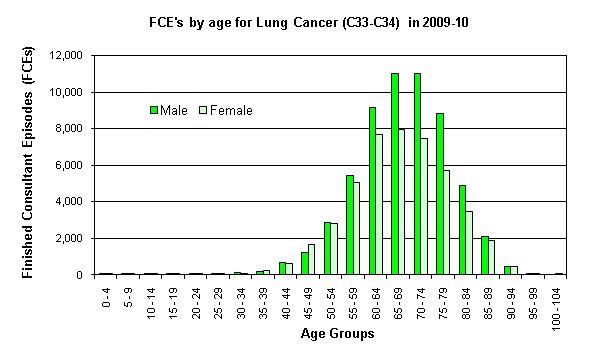IN THIS SITE...

- NHS Choices: Lung cancer
- Macmillan Cancer Support: Cancer Back up
- Inpatient Data
- Self Service
HES on... Lung cancer
This article gives an overview of the condition and highlights related 2009-10 HES data.
What is lung cancer?
Lung cancer (bronchial carcinoma) is cancer of the lining cells of the air tubes (bronchi). There are different types of lung cancer depending on which type of cell in the lungs becomes cancerous.
There are two main types of primary lung cancer (cancer that started in the lungs, rather than spread to the lungs from elsewhere in the body):
- small cell lung cancer (SCLC), which tends to spread rapidly
- non-small cell lung cancer (NSCLC), which tends to be relatively slow growing.
Smoking is known to be the cause of most lung cancers. Other causes include prolonged or close contact with asbestos, uranium, chromium and nickel.
Who does it affect?
According to NHS Choices, around 31,000 people are diagnosed with lung cancer in England and Wales each year.
Lung cancer is more common in people over 40. (see graph below).
 |
HES facts and figures
HES data for lung cancer (diagnosis codes C34 & C78.0 in ICD-10) shows that in 2009-10:
- it was responsible for 115,900 episodes of admitted patient care, accounting for 380,895 FCE bed days
- more hospital admissions for lung cancer are from waiting lists than emergency admissions
- 29,371 (25.3%) lung cancer episodes did not include a procedure
- where procedures were known to be carried out on admitted patients, the most common were:
- procurement of drugs for chemotherapy for neoplasm in Bands 1 - 5 (X70 in OPCS-4.6) - accounted for 18,275 (15.7%) of all episodes for lung cancer
- procurement of drugs for chemotherapy in neoplasm in Bands 6 - 10 (X71 in OPCS 4.6) - accounted for 13,830 (11.9%) of all episodes for lung cancer
- delivery of chemotherapy for neoplasm (X72 in OPCS-4.6) - accounted for 11,040 (9.6 %) of all episodes for lung cancer.
More information on this topic is available from the following:
- NHS Choices
- Macmillan Cancer Support

